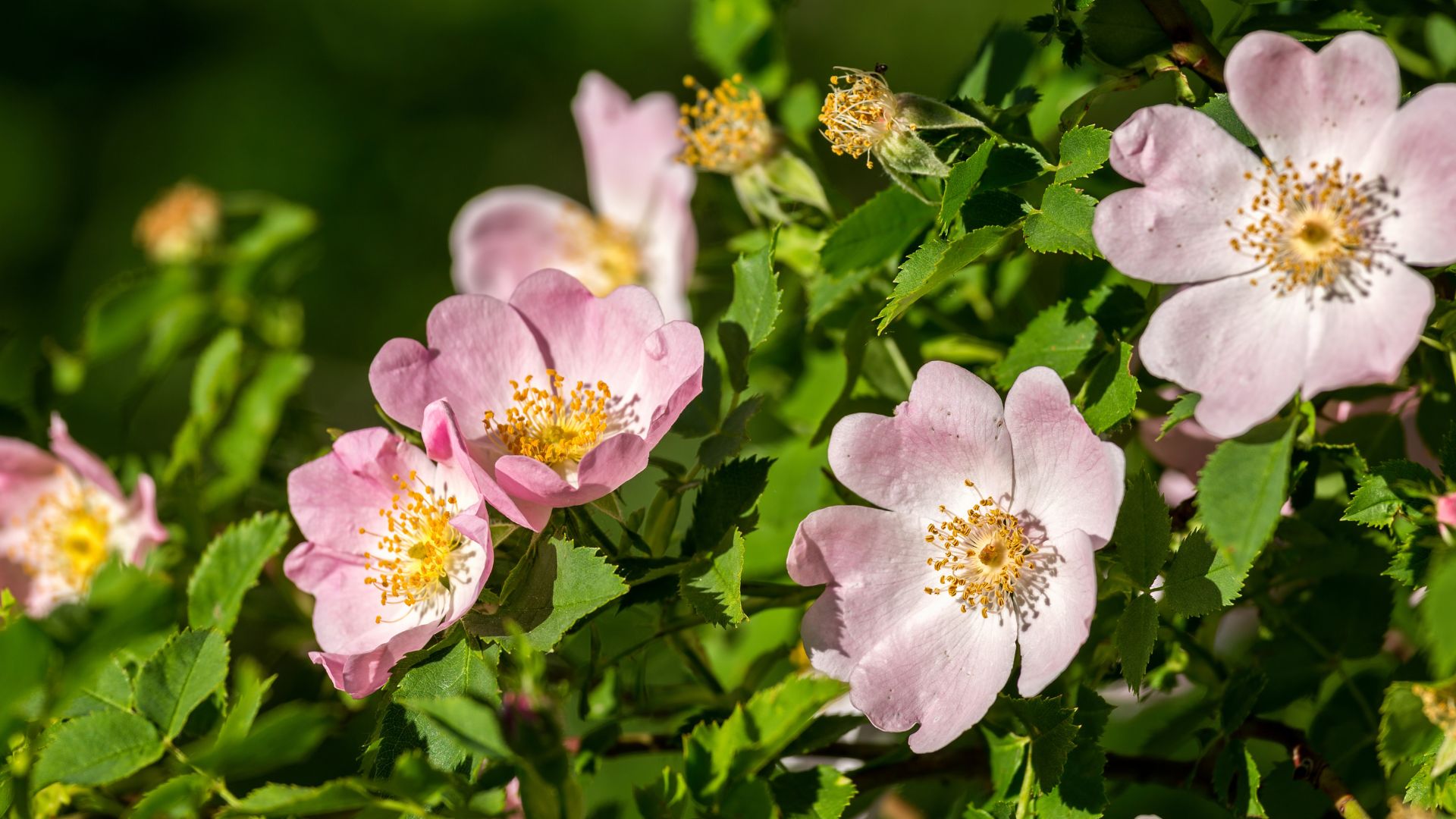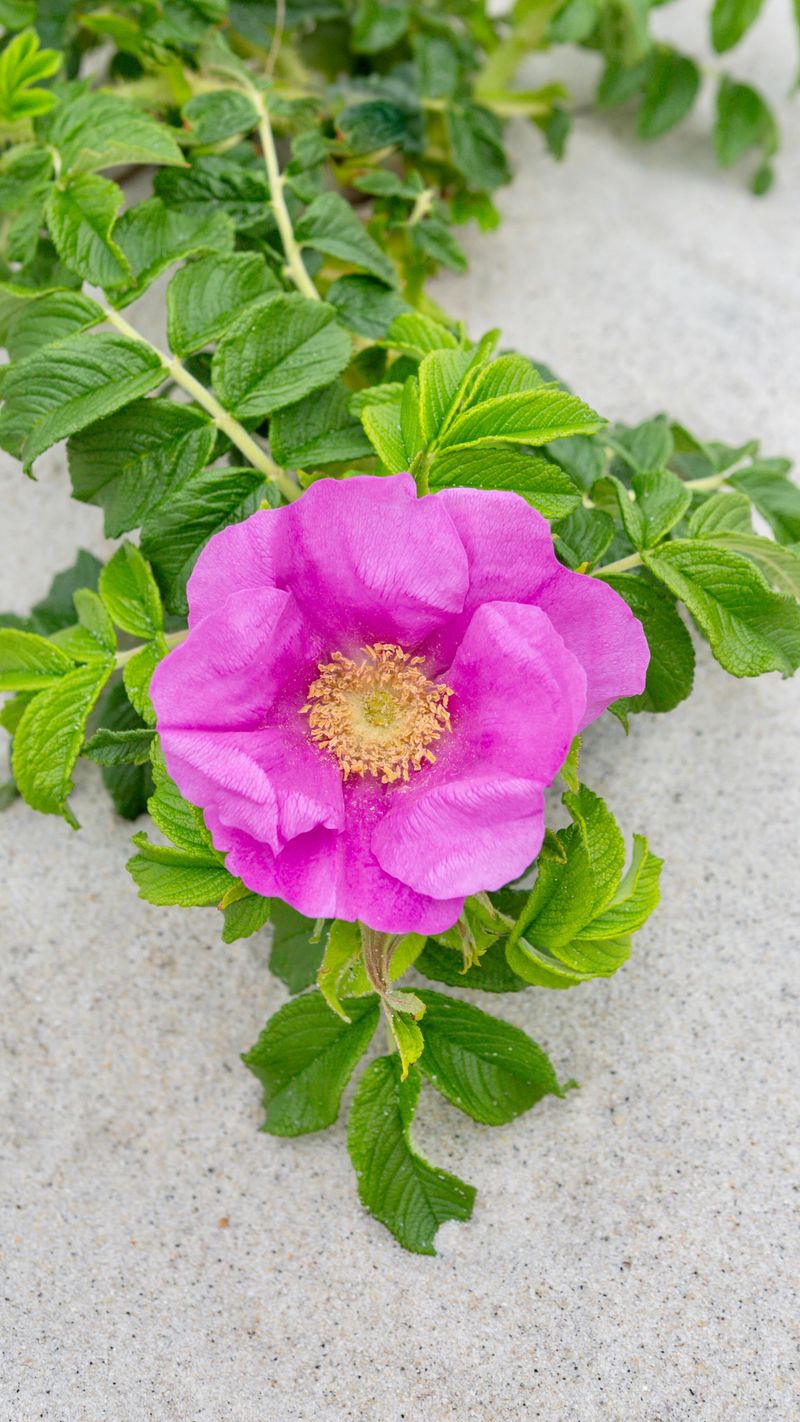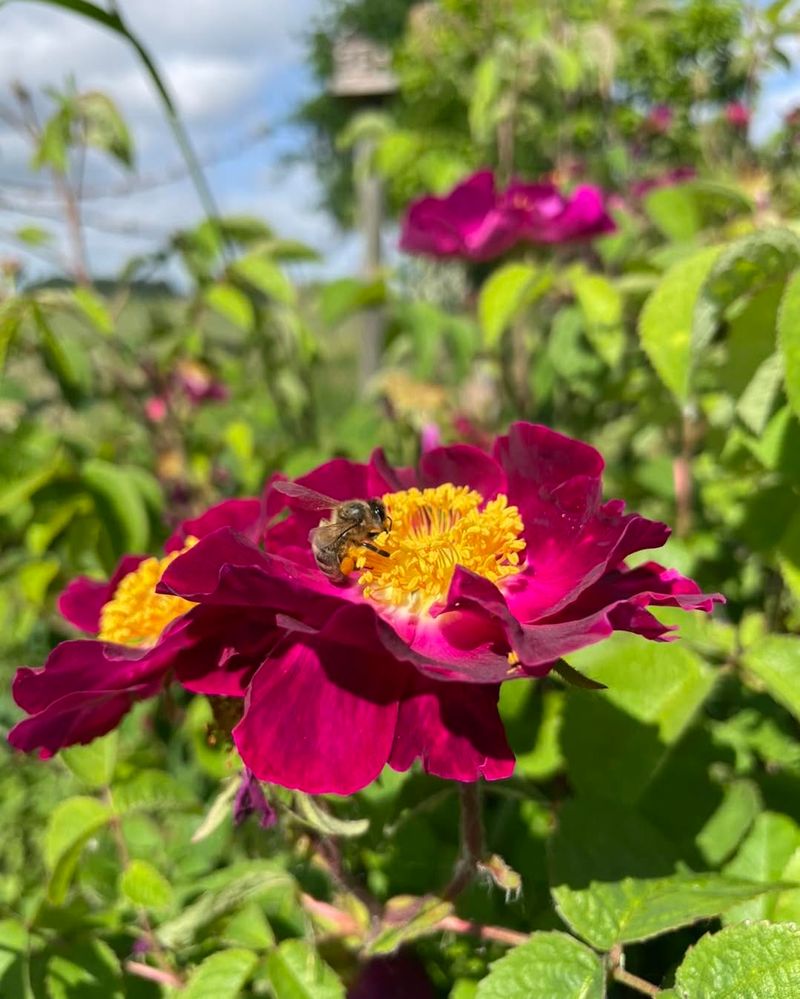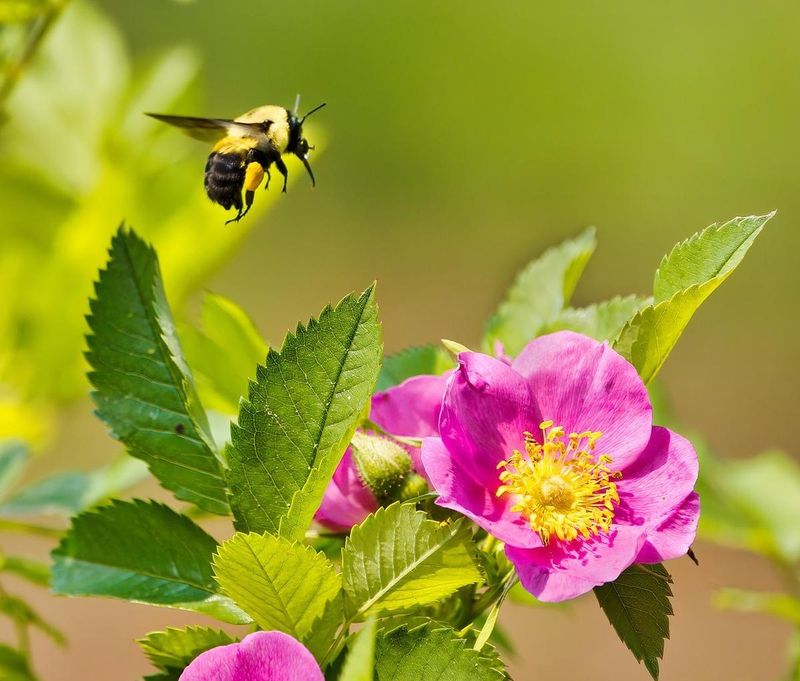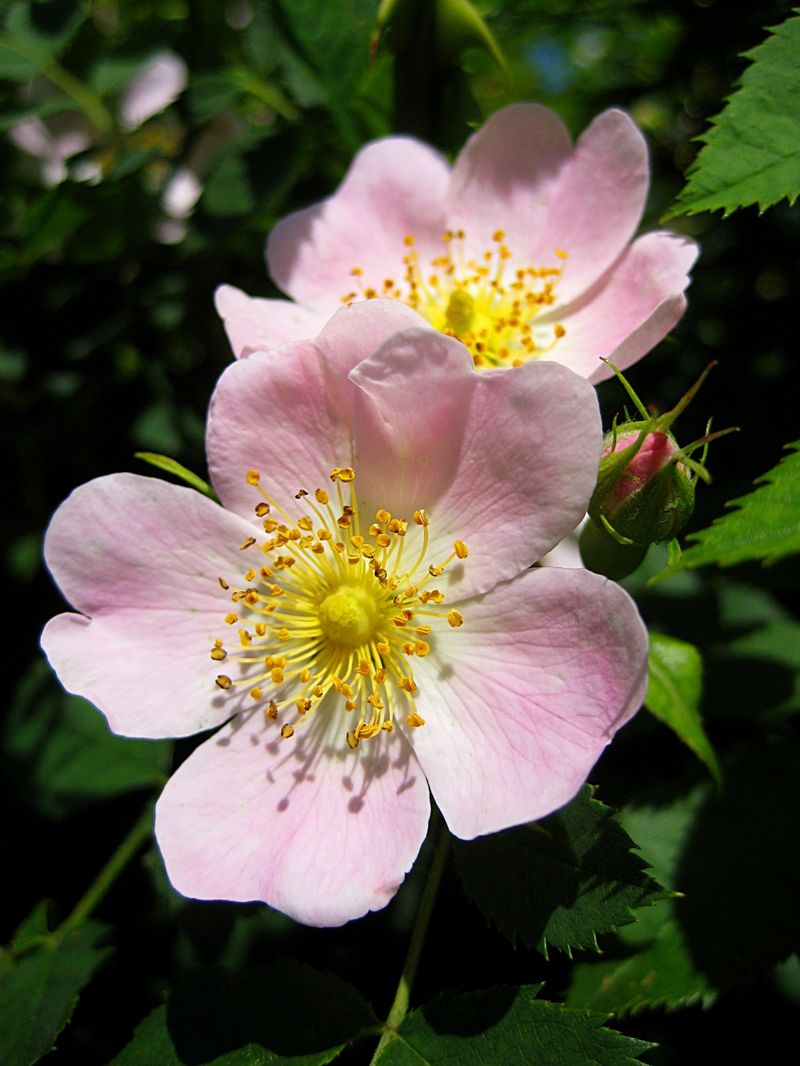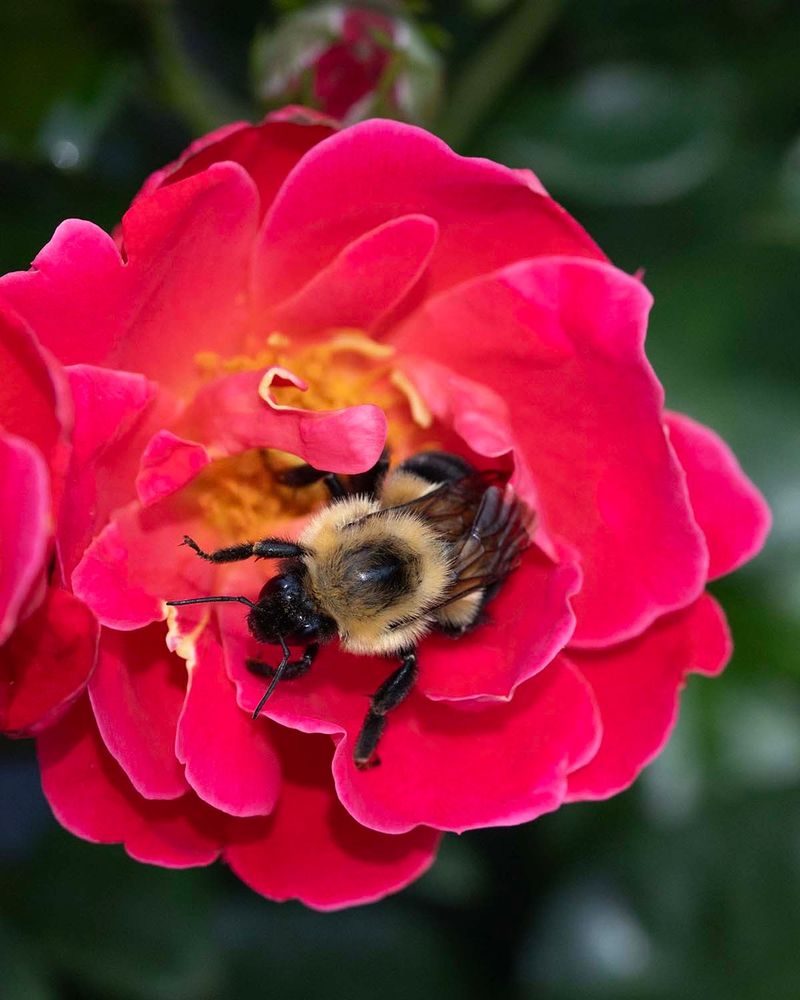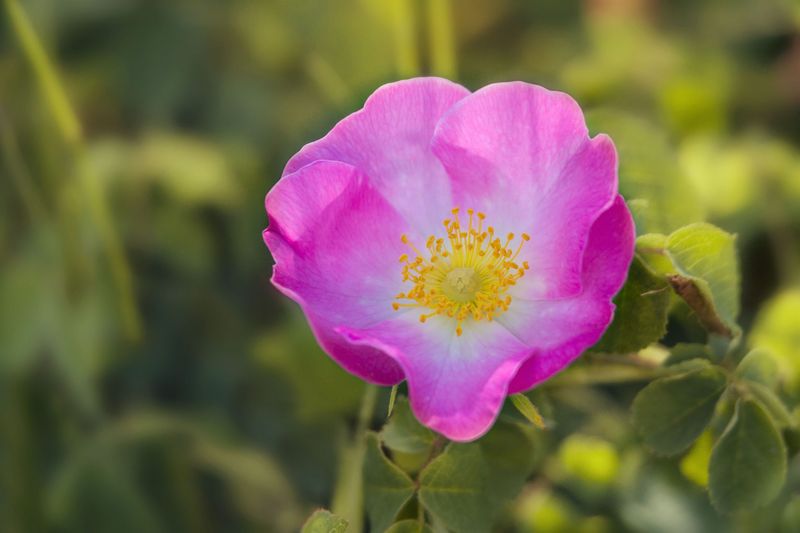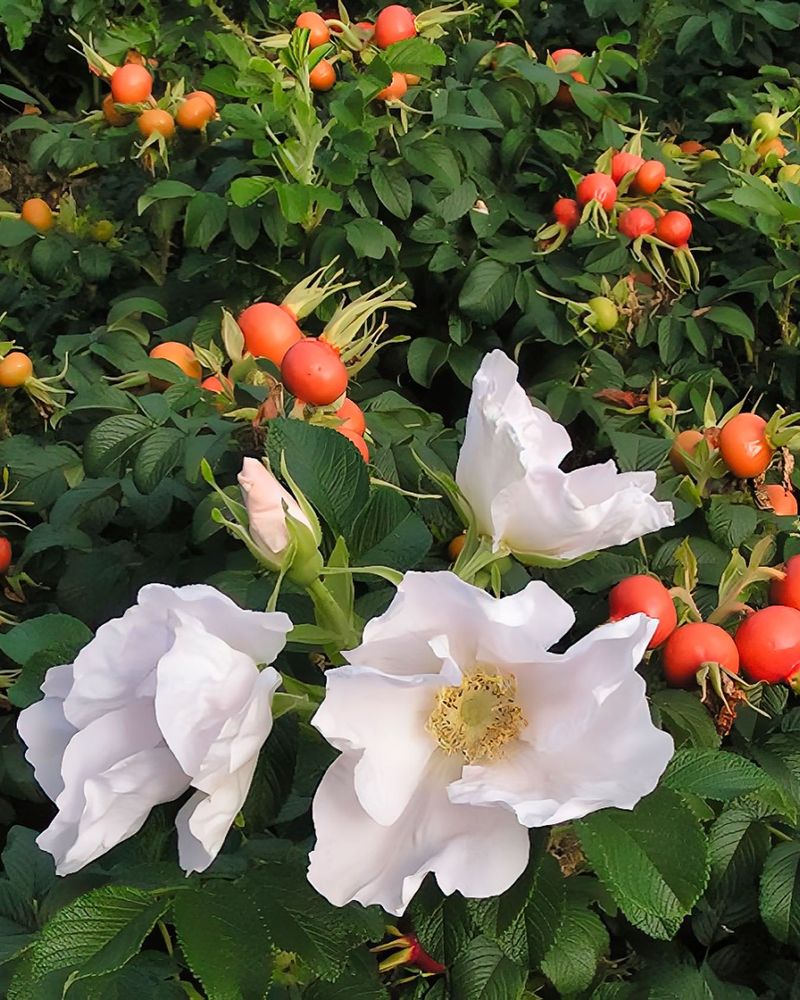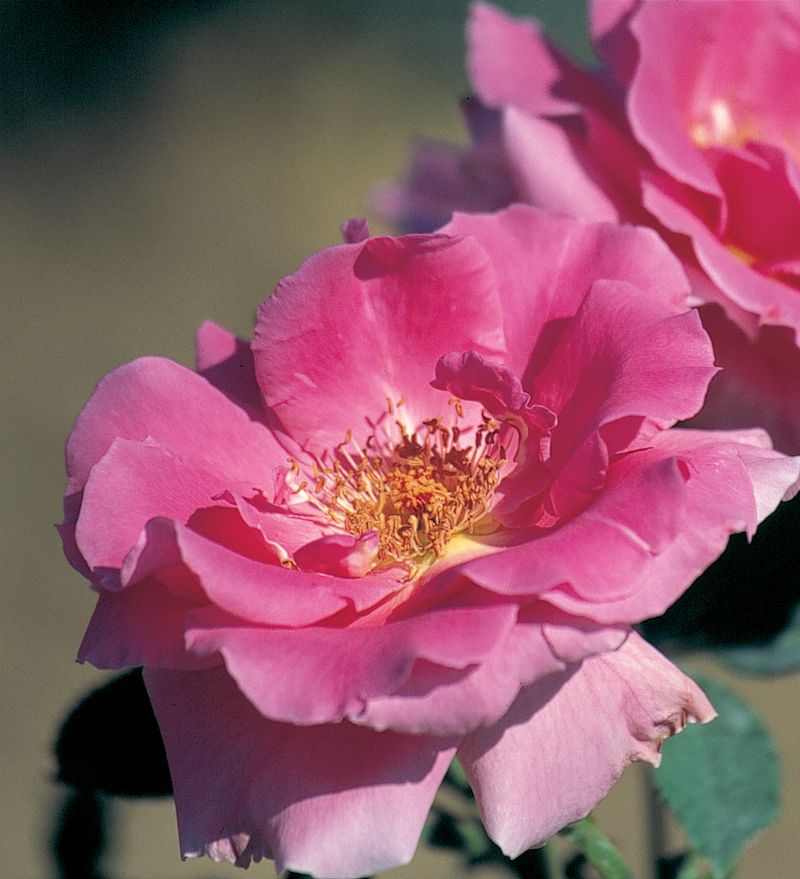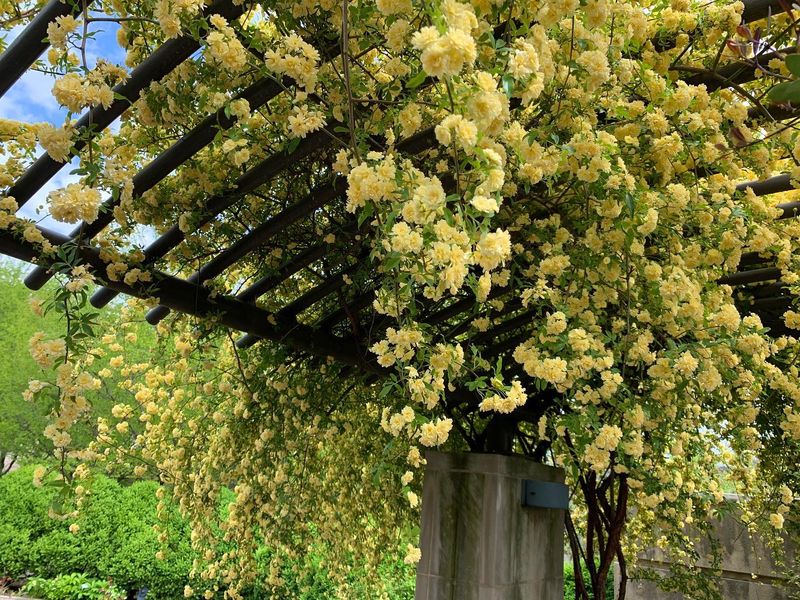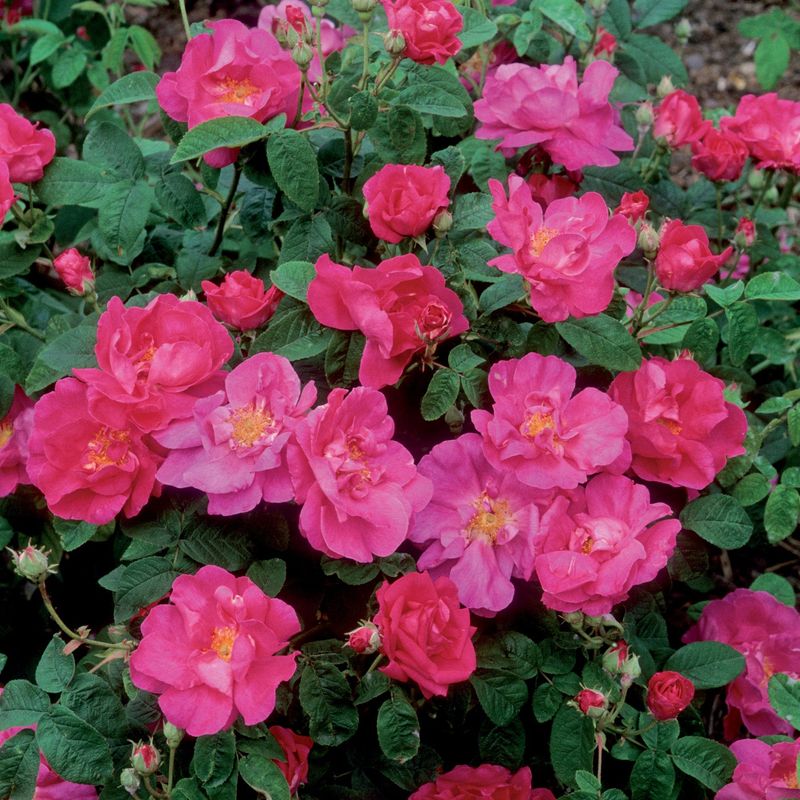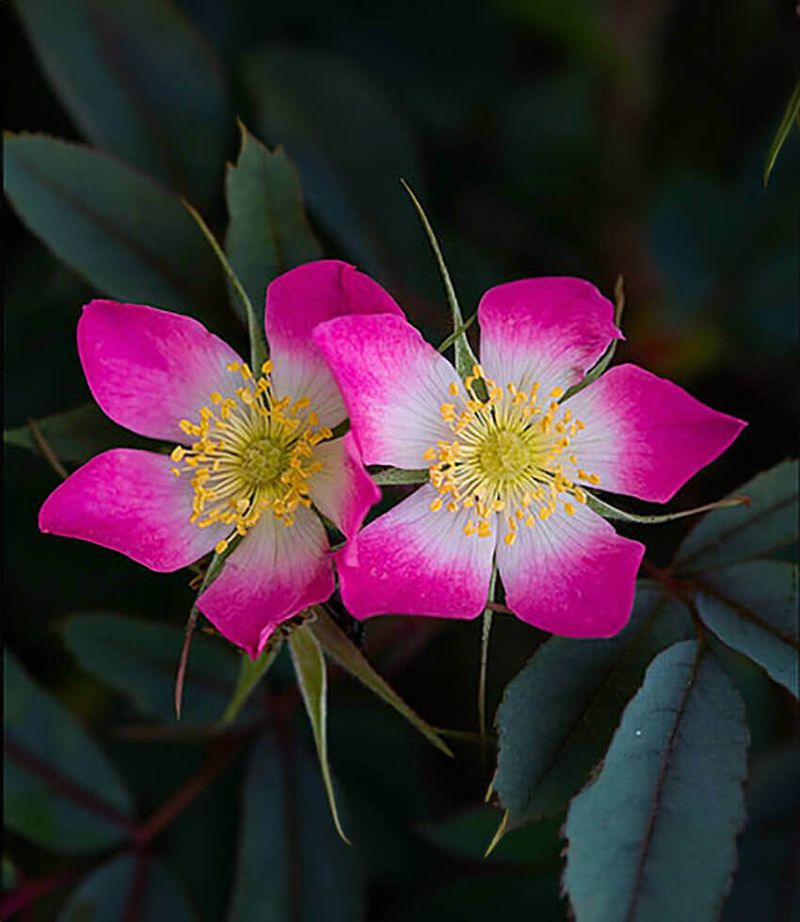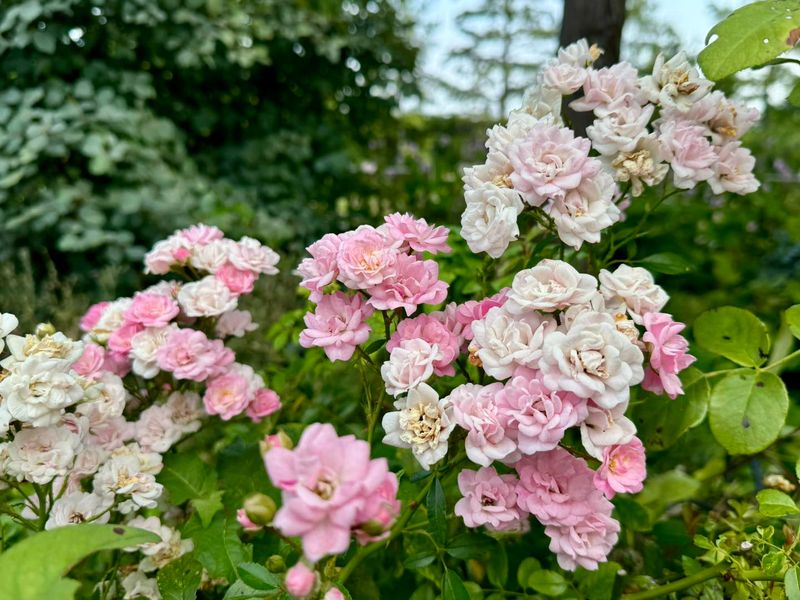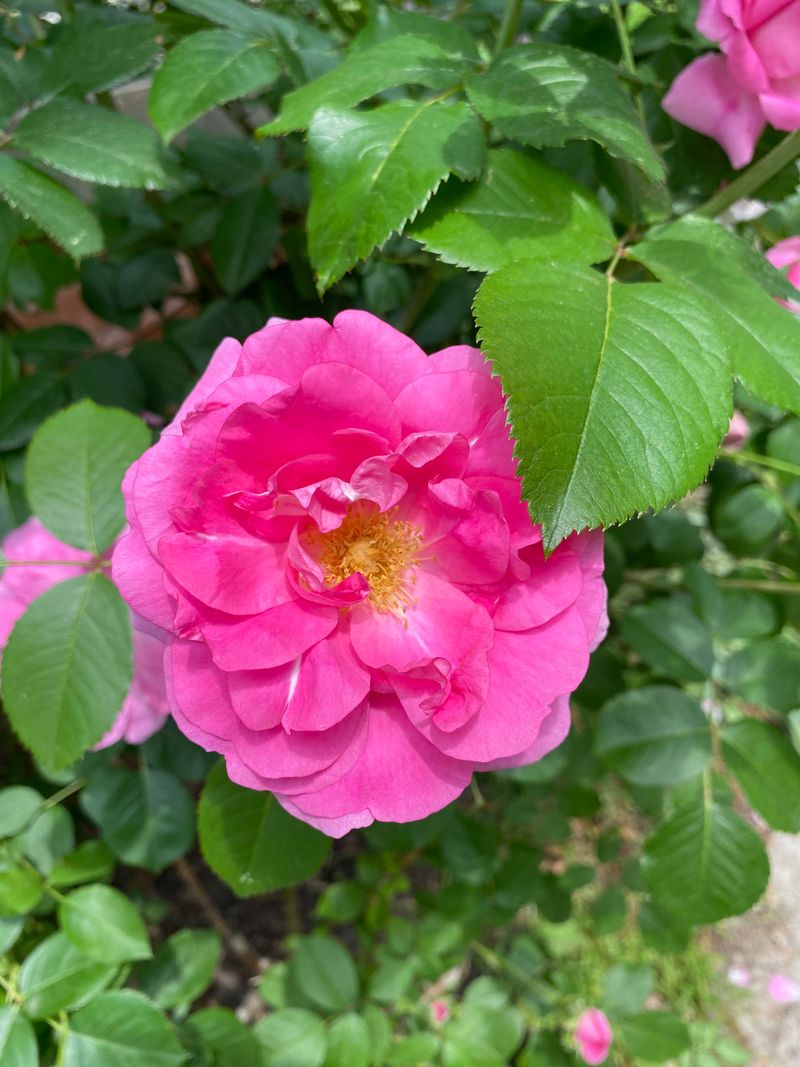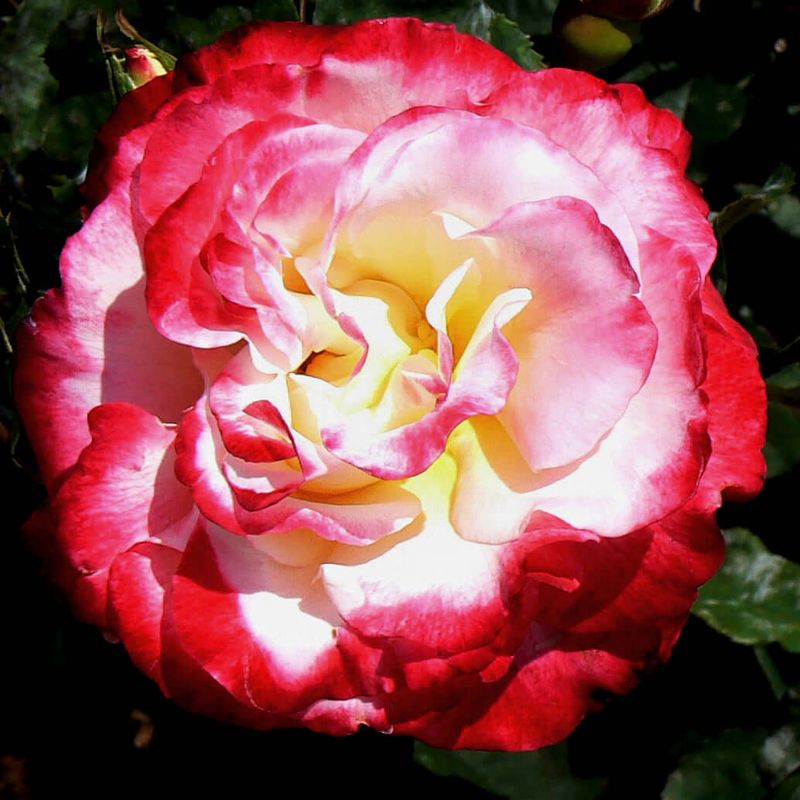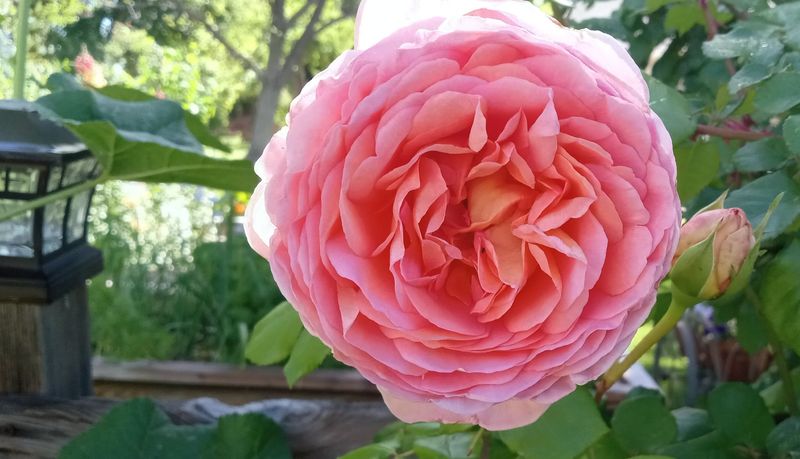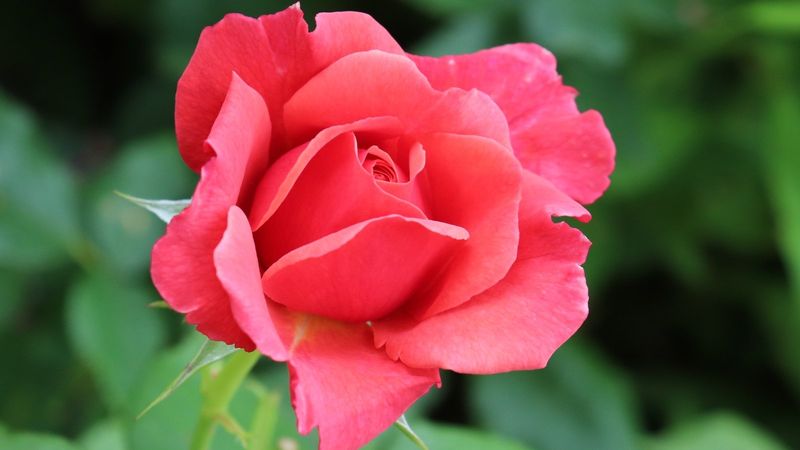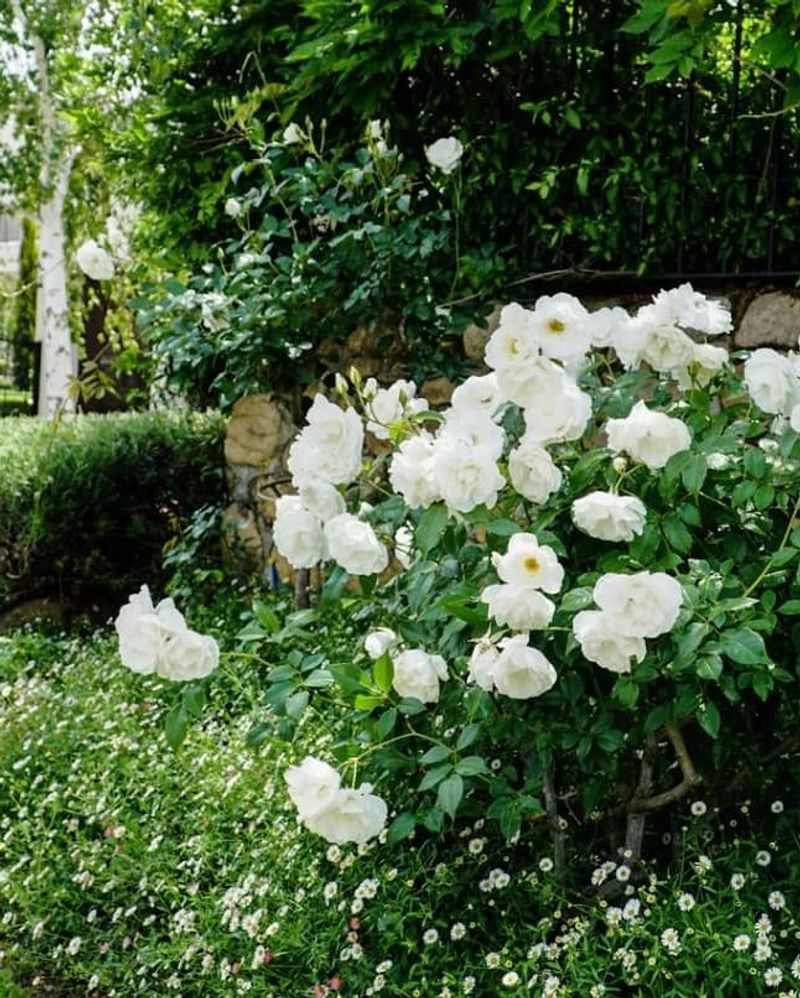Roses aren’t just there to look pretty—they can actually play a big role in supporting pollinators. I used to think all roses were equal, but I quickly noticed that some were buzzing with bees while others sat completely ignored. It turns out the type of rose you plant really does make a difference.
Some modern hybrids are bred more for looks than function, often losing the fragrance and open shape that pollinators love. Meanwhile, old-fashioned or single-petal varieties tend to draw in bees, butterflies, and even the occasional hummingbird like magnets.
If you’re trying to create a garden that’s not just beautiful but also helpful to local wildlife, picking the right roses is a great place to start. It’s a simple switch that brings both color and life to your space.
1. Wild Beach Rose (Rosa rugosa)
Bees can’t get enough of the simple, open flowers that offer easy access to pollen and nectar. The strong, spicy scent acts like a dinner bell, calling pollinators from surprising distances across your garden.
I’ve watched honeybees practically fight for position on these blooms in my coastal garden. The five-petaled structure means there’s no maze of petals to navigate, making feeding quick and efficient for busy bees.
As an added bonus, after the spring and summer blooming period, the plant produces large red rose hips that birds love. This makes beach roses a two-season wonder for wildlife in your garden.
2. Gallica Rose (Rosa gallica)
Ancient and fragrant, these roses date back to Roman times and feature single to semi-double blooms that pollinators can easily access. The shallow cup shape provides a perfect landing pad for bees and butterflies seeking nectar.
During mid-morning hours, my Gallica roses become buzzing hubs of activity. The relatively flat flower structure allows even shorter-tongued bees to reach the rewards inside, making them democratic feeding stations for various pollinator species.
Unlike modern hybrids bred primarily for looks, these heritage roses maintain strong connections to their wild ancestors. This genetic authenticity means they produce more viable pollen and nectar, making them genuine pollinator magnets in any garden setting.
3. Swamp Rose (Rosa palustris)
Native to eastern North America, this wild rose thrives in wet areas where many other roses would fail. The simple pink flowers offer abundant pollen that native bees collect with remarkable enthusiasm throughout the summer months.
What makes this rose special is its extended blooming period. While many roses put on a brief show, swamp roses keep producing flowers for weeks, providing reliable food for pollinators during seasonal gaps when other plants aren’t flowering.
Their natural resistance to disease means you won’t need chemicals that might harm beneficial insects. For anyone with a rain garden or wet spot, this rose creates a perfect partnership between beauty and ecological function.
4. Dog Rose (Rosa canina)
Found growing wild in hedgerows across Europe, this rose features simple, open flowers that provide an all-you-can-eat buffet for bees. The blossoms produce copious amounts of pollen that dusts visiting insects with golden treasure.
Unlike fancy garden varieties, dog roses evolved alongside native pollinators, creating perfect partnerships. The timing of their bloom coincides precisely with when certain bee species need them most—an evolutionary synchronicity that benefits both plant and pollinator.
Beyond bees, these roses attract hover flies and solitary wasps that help control garden pests. I’ve noticed fewer aphid problems in areas near my dog roses, showing how supporting pollinators can create better balance throughout your garden ecosystem.
5. Single Knock Out Rose (Rosa ‘Radrazz’)
Though developed for disease resistance rather than pollinator appeal, the single-flowered versions of Knock Out roses have become unexpected bee favorites. Their open centers and accessible stamens make them practical feeding stations despite their modern breeding.
The nearly continuous bloom from spring until frost creates a reliable food source when many other plants have finished flowering. This dependability makes them valuable bridge plants that help pollinators through difficult seasonal transitions.
For gardeners wanting low-maintenance roses that still support wildlife, these workhorses deliver both beauty and function. The original red single Knock Out attracts more bees than its double-flowered cousins, proving that simpler flowers often make better ecological choices.
6. Sweetbriar Rose (Rosa rubiginosa)
Beyond visual appeal, this European native’s secret weapon is its apple-scented foliage that intensifies after rain. The fragrance attracts pollinators even before the flowers open, bringing beneficial insects to your garden earlier in the season.
The simple pink flowers provide easy landing pads for bees of all sizes. Even tiny sweat bees that struggle with complex flowers can efficiently gather resources from sweetbriar roses without wasting precious energy.
Having grown these in my garden for years, I’ve noticed they attract a more diverse pollinator community than any other rose. From carpenter bees to mining bees to tiny metallic green bees—the variety of visitors suggests this rose produces exceptionally high-quality nectar and pollen.
7. Rugosa Alba (White Rugosa Rose)
The pure white version of rugosa roses offers the same pollinator benefits as its pink cousins but with an even stronger fragrance that carries on the breeze. Bees will actually abandon other flowers when these start blooming—I’ve timed their rapid flight path changes!
The slightly cupped shape creates a protected microclimate where bees can work even on windy days. This architectural feature makes these roses reliable feeding stations during challenging weather when other flowers might be inaccessible.
These tough roses tolerate salt spray, making them ideal for coastal gardens where pollinators often struggle to find sufficient food sources. The combination of resilience and ecological value makes them standout performers for pollinator-focused landscapes.
8. Carefree Beauty Rose (Rosa ‘Bucbi’)
Developed by Buck at Iowa State University, this rose was bred for cold hardiness but accidentally became a pollinator paradise. The semi-double pink blooms offer just enough petals to look full while still allowing easy access to the reproductive parts bees seek.
The continuous blooming habit from late spring through fall provides dependable nutrition when many native plants have finished flowering. This extended season helps support late-generation butterflies and bees preparing for winter.
My garden journal notes show more consistent bee visits to these roses than any other variety during hot summer afternoons. Their ability to keep producing flowers and nectar even during drought and heat stress makes them reliable partners for pollinators during challenging weather periods.
9. Lady Banks Rose (Rosa banksiae)
This Chinese climbing rose produces clusters of small, open flowers that create massive feeding stations for pollinators. The sheer abundance of blooms on a single plant can support dozens of bees simultaneously during its spectacular spring display.
Though lacking fragrance, these roses compensate with visual signals and abundant pollen that attracts primarily native bees rather than honeybees. The yellow variety seems particularly magnetic to small carpenter bees that efficiently harvest its resources.
Growing up to 20 feet tall, Lady Banks creates vertical pollinator habitat in spaces where ground-level planting might be limited. For urban gardens or properties with minimal square footage, this rose delivers maximum ecological impact per square foot of soil.
10. Apothecary Rose (Rosa gallica ‘Officinalis’)
One of the oldest cultivated roses, dating back to ancient Rome, this variety maintains strong connections to its wild ancestors. The semi-double crimson flowers still allow bees access to pollen despite having more petals than truly wild roses.
Blooming just once in late spring creates a concentrated feeding bonanza that coincides with when many bee species are establishing nests. This timing makes it especially valuable for supporting the reproductive phase of native bee life cycles.
Beyond bees, I’ve observed this rose attracting specialist rose-visiting insects that few other garden plants support. By growing ancient varieties like this, gardeners help preserve not just plant genetics but also the specialized relationships between plants and pollinators that have evolved over centuries.
11. Species Rose Rosa glauca (Formerly R. rubrifolia)
This European native combines wildlife value with striking purple-tinged foliage that adds color even when not in bloom. The simple pink flowers appear in early summer, providing pollen when many spring bloomers have finished.
Unlike modern roses that demand perfect conditions, Rosa glauca thrives in poor soil and partial shade where few roses grow. This adaptability allows gardeners to support pollinators in challenging spots where options are limited.
After flowering, the small red hips persist well into winter, feeding birds long after insect activity has ceased. This multi-season support for wildlife makes it an ecological powerhouse despite its understated appearance compared to showier garden roses.
12. The Fairy Rose (Rosa ‘The Fairy’)
Despite being a polyantha rose with clusters of small flowers, this variety maintains centers open enough for bee access. The spray-like bloom pattern creates multiple feeding stations within each flower cluster, supporting several pollinators simultaneously.
The continuous blooming habit from June until frost provides reliable nutrition during summer gaps when many native plants have finished flowering. This dependability makes it a cornerstone species for maintaining pollinator populations throughout the growing season.
At just 2-3 feet tall, this compact rose fits even in small gardens or containers. The ecological impact belies its modest size—I’ve counted five different bee species visiting a single plant within a fifteen-minute observation period during peak bloom.
13. William Baffin Climbing Rose
This Canadian explorer rose combines cold hardiness with pollinator-friendly semi-double blooms that remain accessible despite having more petals than wild roses. The deep pink flowers grow in clusters that allow bees to move efficiently between blooms without wasting energy on long flights.
As a repeat bloomer, it provides multiple feeding opportunities throughout the growing season. The first flush coincides with spring native bee emergence, while later blooms support summer specialists and butterflies preparing for migration or reproduction.
The climbing habit creates vertical pollinator habitat, effectively multiplying the feeding stations in limited space. When trained along a fence or trellis, a single plant can support dozens of pollinators simultaneously during peak bloom periods.
14. Double Delight Hybrid Tea Rose
Famous for its cream and red bicolor blooms, this rose represents the first entry in our “bees ignore” section. The extremely high petal count—often exceeding 30 petals per flower—creates an impenetrable barrier that blocks access to pollen and nectar.
Breeding focused exclusively on human preferences has eliminated the accessible reproductive structures that pollinators need. Even when fully open, the tight spiral of petals leaves no clear path to the flower’s center.
Despite its powerful fragrance that might initially attract pollinators, bees quickly learn these flowers offer no reward for their efforts. During garden observations, I’ve watched bees approach, briefly investigate, then abandon these blooms in favor of simpler flower structures nearby.
15. English Roses ‘Abraham Darby’
Created by David Austin, these roses were bred to combine old rose fragrance with modern repeat flowering. Unfortunately, the densely packed petals—sometimes more than 70 per bloom—make them impossible fortresses for most pollinators to penetrate.
The cupped shape traps the reproductive structures deep within a maze of petals. Even determined bees cannot navigate to the center without expending more energy than the potential reward justifies.
During side-by-side testing in my garden, these roses received virtually no pollinator visits while nearby single-flowered varieties buzzed with activity. The breeding that made these roses spectacular for human enjoyment simultaneously rendered them ecologically non-functional for the insects that sustain our gardens.
16. Grandiflora Rose ‘Queen Elizabeth’
This classic pink rose produces the elegant, high-centered buds prized by florists but ignored by bees. The tightly packed petals unfurl in a spiral pattern that effectively blocks access to pollen even when the flower appears fully open to human observers.
The breeding focused on creating perfect form and long vase life has eliminated the natural openness that allows pollinator access. The stamens—when present at all—are modified to be ornamental rather than functional.
Many gardeners mistakenly assume all roses support pollinators, but watching this variety on a sunny day reveals the truth. While nearby single roses host constant visitors, Queen Elizabeth stands beautiful but ecologically silent, receiving perhaps one exploratory visit for every fifty at simpler varieties.
17. Floribunda Rose ‘Iceberg’
Though producing abundant clusters of white flowers, this popular landscape rose falls into our “pollinators ignore” category due to its moderately double form. The multiple layers of petals create just enough of a barrier to discourage most bee species from making the effort to reach center resources.
The lack of strong fragrance compounds the problem, as bees rely heavily on scent to locate high-value food sources. Without this chemical signal, many pollinators simply fly past these roses despite their visual prominence in the landscape.
I’ve experimented with placing blue mason bee houses near these roses, hoping proximity might encourage visits. Even with nesting sites directly adjacent, the bees consistently bypassed Iceberg in favor of simpler flowers further away—clear evidence of their ineffectiveness as pollinator plants.

